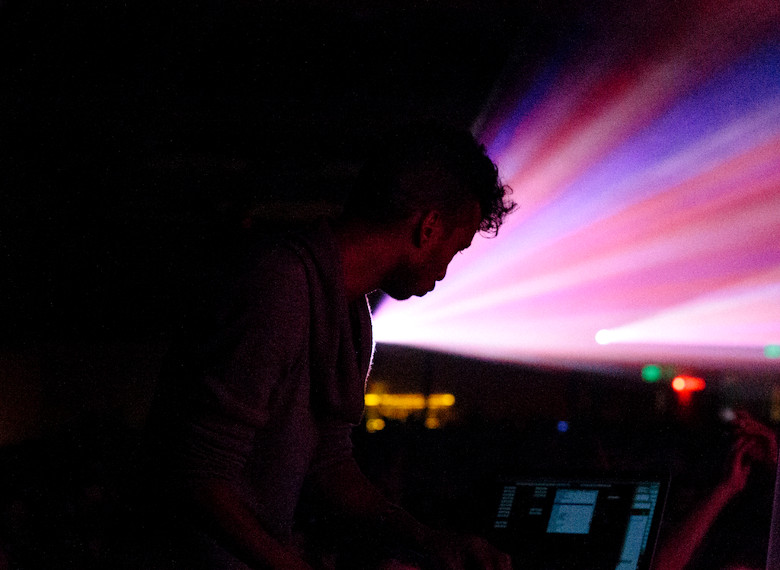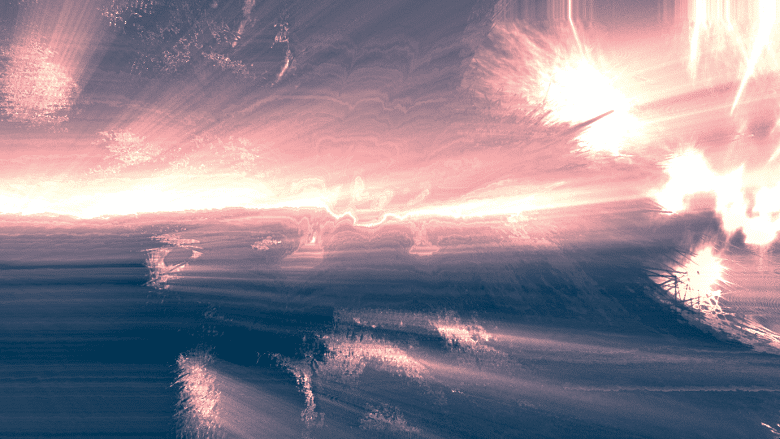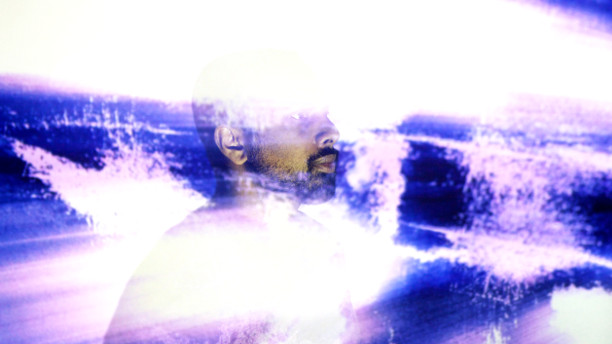Foto: Studio Tape Echo (Paul Jebanasam)
Paul Jebanasam’s new album Continuum, released on Subtext in February, sits between apparent dichotomies: Strings meet white noise, scientific aesthetics meet religious connotations. Together with visual artist Tarik Barri, he will now add yet another dimension to his music: Both will tour with a joint audio-visual show throughout Europe. Read our interview with the two and win tickets for their gig at Vienna’s Sound:Frame festival on April 15th below!
Paul, according to the press release for Continuum „the album sits at a meeting point of fiction, composition and philosophy“. Can you elaborate on that? What exactly was your concept for this album?
Jebanasam: Whenever I’m working on a project I often allow myself to forget that the end result will necessarily take one form or another. I find this process really useful as it allows me to speculate and think through ideas freely without first having to ask whether the medium supports the direction I feel like going in. This also helps keep the whole thing together when it’s translated into an audio-visual piece as is the case with this project. One of the concepts that helped tie the different threads of thought together was the relationship between energy and life and how this works at various levels. On one level, life by a certain definition is something which stores energy, resisting entropy through various structures that evolve to be more and more complex over time. But it never wins ultimately – energy is dispersed, living matter dies and time in the context of entropy moves in one direction as far as we can observe. On another level, when thinking about humans and in particular our development of technologies like information systems or high energy physics experiments like those involved in nuclear fusion, these structures feel connected to this same very primitive purpose but not in ways I understand personally. Whether we are trying to recreate the energy of a star to power our lives or we are collectively building some kind of living artificially intelligent organism, we are essentially trying not to die. Trying to resist this fundamental behaviour of a universe governed by strict physical laws. This is the point is where I find it easier to let art, fiction, sound etc take over rather than scientific or philosophical thinking. Perhaps as I don’t have the full set of tools needed to reach any kind of conclusion via those routes. When working with sound and light in the form of moving images though, the whole thing could possibly be something more experiential rather than theoretical. That’s the intent of the work – to turn these ideas into another kind of energy.
Video: Paul Jebanasam – Continuum (visuals by Tarik Barri)
Continuum merges organ sounds and digital noise, thus bringing together sounds we would consider to be organic and those that seem artificial to us. What makes this apparent dichotomy so interesting for you in the context of the album’s concept?
Jebanasam: It is not so much the dichotomy that is interesting as much as the sense that there is no distinction between the organic and the artificial. That seems like a very human construct and from another point of view, whether the energy is being supplied by a human gesture or a network of coded objects is immaterial. The purpose is the same. On a sonic composition level though – there is very little on this album that is primarily the work of human output. The organs, strings and choirs are all virtual and synthesised in a computer whereas the apparently digital noises mostly originated in the real world via the use of electrical hardware. What I was primarily interested in overall is the states of energy and material properties that are possible. The speeds, heat levels, densities, etc., and how these interact with each other over time. Each element of this piece has a specific trajectory and this governs its place in the overall structure.
„We are fundamentally seeking a God-like relationship to life and matter.“ (Paul Jebanasam)
Religious themes are quite prominent in your work and you have immersed yourself in liturgical music quite a lot. Where does your interest for that come from? Polemically speaking, it seems to oppose your other field of expertise, technology and science.
Jebanasam: This is something I’m still trying to understand. My mother is Catholic so that’s likely played a role somewhere but I personally have always been drawn to scientific explanations for the world. They don’t seem opposed necessarily though if you consider the limits of either field rather than their core principles of faith and reason respectively. Also, somewhere in between the two is science fiction which in some cases, feels like a religious mythology for the future. Even speculations about AI are part of another creation myth but one that we would play a very different part in. This is partly why I’ve been drawn to thinking about scientific efforts to extend the lifespan of humanity as a whole from a theological perspective. It seems driven not only by a curiosity to know the answer – we are fundamentally seeking a God-like relationship to life and matter.

Tarik, you have studied biological psychology but dropped out to study music and technology. Why this drastic change of direction? And how might your background in biological psychology have influenced your art?
Barri: While studying biological psychology John Peel played a track of mine on BBC radio. That woke me up and for the first time I saw that perhaps it could be more than an unrealistic dream to do something with music professionally. I had never considered myself truly able of actually being an Artist, but if Mr. Peel thought that my work is worth while, who knew how far this could go? Now that thought became a splinter in my brain that would stay there forever and get horribly infected if I just left it there. I realised that not giving this a real shot would leave me full of regrets so I just had to. I don’t think that my studying biological psychology plays a direct role in what I create. But it’s the interest that drove me to study that does. That’s an interest in the unknowns of the nature of our experiences. How do we perceive reality? What happens when we receive information through different senses and how does our mind combine these different sources to mentally construct one unified whole? And… how does one manipulate that, play around with it? Biological psychology would have been a more methodical approach to research that, but also more reductionist. What I do now yields no scientific data whatsoever but as I make specific use of imagery and audio, it does create within me the perception of an alternate reality. It feels like I’m discovering what may be experienced when the rules of this reality are changed. This discovery feels both deeply personal and completely universal. That inexplicable feeling which flows simultaneously inward and outward is what I ultimately wish to share with the audience.
You have developed your own software with which you will perform during your joint A/V show. How does that software work?
Barri: My software “Versum” quite literally creates an alternate, computer-generated reality with dynamic, fluid physical laws which I can and do change in realtime. The visual results are a window into that reality, where we see the laws exert their influence on the structures that live within it. So, we don’t see any prerecorded video or anything; all that you see is what’s happening inside the computer’s imagination, its what the computer creates on the basis of the algorithms that I programmed. Just like the audience, I observe what is happening, but I also constantly make adjustments. I manipulate the rules and structures, weakening certain forces while strengthening others, speeding up or slowing down time, expanding or compressing space, etc. I do this all in conjunction with the music, to tell a bigger story through the combination of image and sound.

How did the two of you come to work together? And how did the idea of doing this special A/V together come about?
Jebanasam: The idea of an AV performance of the work came about really early on in the process, well before the album really started to take shape. The whole conversation about how work like this should be presented live has been going on for a while within Subtext and it was James Ginzburg of Emptyset who suggested I speak to Tarik after working with him on a project for CTM. We sent ideas back and forth and then once it was in motion, plans were made to perform it for the first time at Berlin Atonal. That became our deadline and we worked on it together in Bristol. It was only when we could both experiment with it in the same physical space that it really started to find it’s final form and speak to both of us very clearly. Working with Tarik is quite a unique process. His software works in some ways like a game engine and allows him to choreograph massive virtual events and then move through them in real time that is expressive in a way I’ve never seen before. From a programming perspective alone its a huge technical achievement but on an aesthetic level, the performance in its current form just could not exist if it wasn’t for the capabilities offered by his software.
Considering that Tarik’s work is mostly based on improvisation, does he rather react to Paul’s music or do you actually try to improvise the whole show? If so, how will it differ from what you can hear on the album (besides the lack of visuals, obviously)?
Barri: Improvisation is very much a part of what I do live, but also carefully planned composition plays a big role. You could imagine a live band who play all of their songs and have freedom to improvise upon the structures those songs provide, but the structures themselves are very much rehearsed and known beforehand. That is the way that my improvisation works: I know Paul’s music very well and we both very much adhere to agreements we’ve made. We know where we’re going and we know the way to get there. Exactly how we walk that path though is up to moment-to-moment decisions, and depends very much on our interaction on stage.
Jebanasam: Yes, at a certain scale the structure is completely locked in place but as these sections are quite large it still allows for variation within the parts whilst keeping the whole thing intact. Each performance involves testing out some new additional material and techniques which is great as it feels like the project is alive and growing. We’re also working on versions that are visually and sonically more immersive. In terms of the audio, we’re developing a multi-channel surround version and looking into options to present that shortly. To that end I’ve been exploring the use of a spherical speaker array in a space for ambisonic research that has recently been setup at the university where I work. Regarding visuals, we’ve been developing the technology to project on dome-shaped surfaces too. It’s been a big challenge getting the material to sit right in this context, especially when it was first created for more traditional setups but with the help of some very clever people and their algorithms, a dome projected version of Continuum will soon be a reality.
We are giving away 2×1 tickets for Sound:Frame TEN x Brut I at Brut with Paul Jebanasam & Tarik Barri amongst others. Please send us an e-mail with the subject line COntinuum until Thursday, April 14th!
Sound:Frame TEN x Brut I at Brut
April 15th 2016
Line-up: Paul Jebanasam & Tarik Barri (live A/V), Toju Kae & Jelena Veljkovic (live A/V), Swede:art x Jay Scarlett feat. Esther Adam (live), Nita. (live visuals), dø√∑ Ç@K∑::: (DJ), Curley Sue (DJ), Sounds of Blackness (DJ)
Ticekts: from 12€
Brut
Karlsplatz 5
1010 Vienna
Austria
